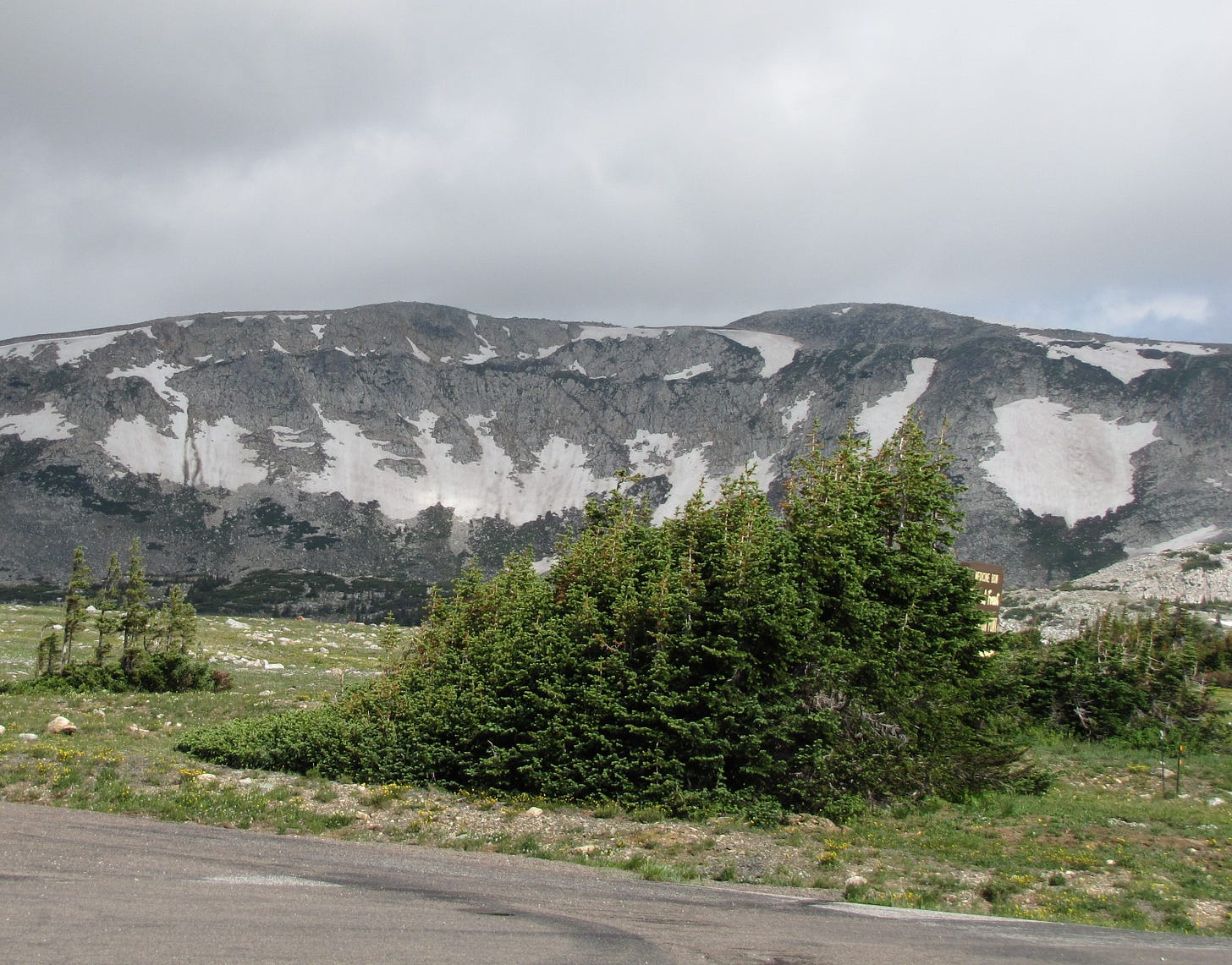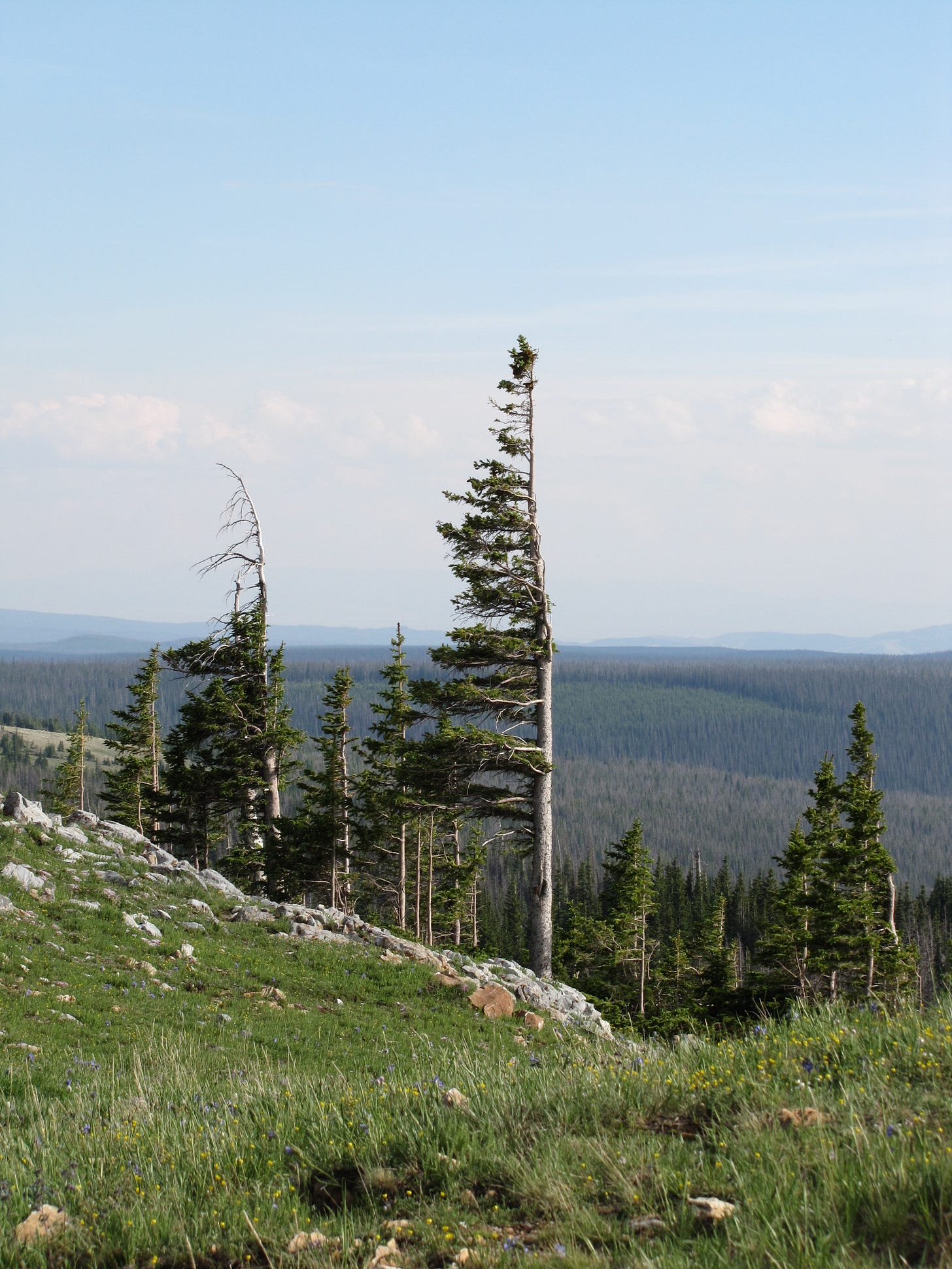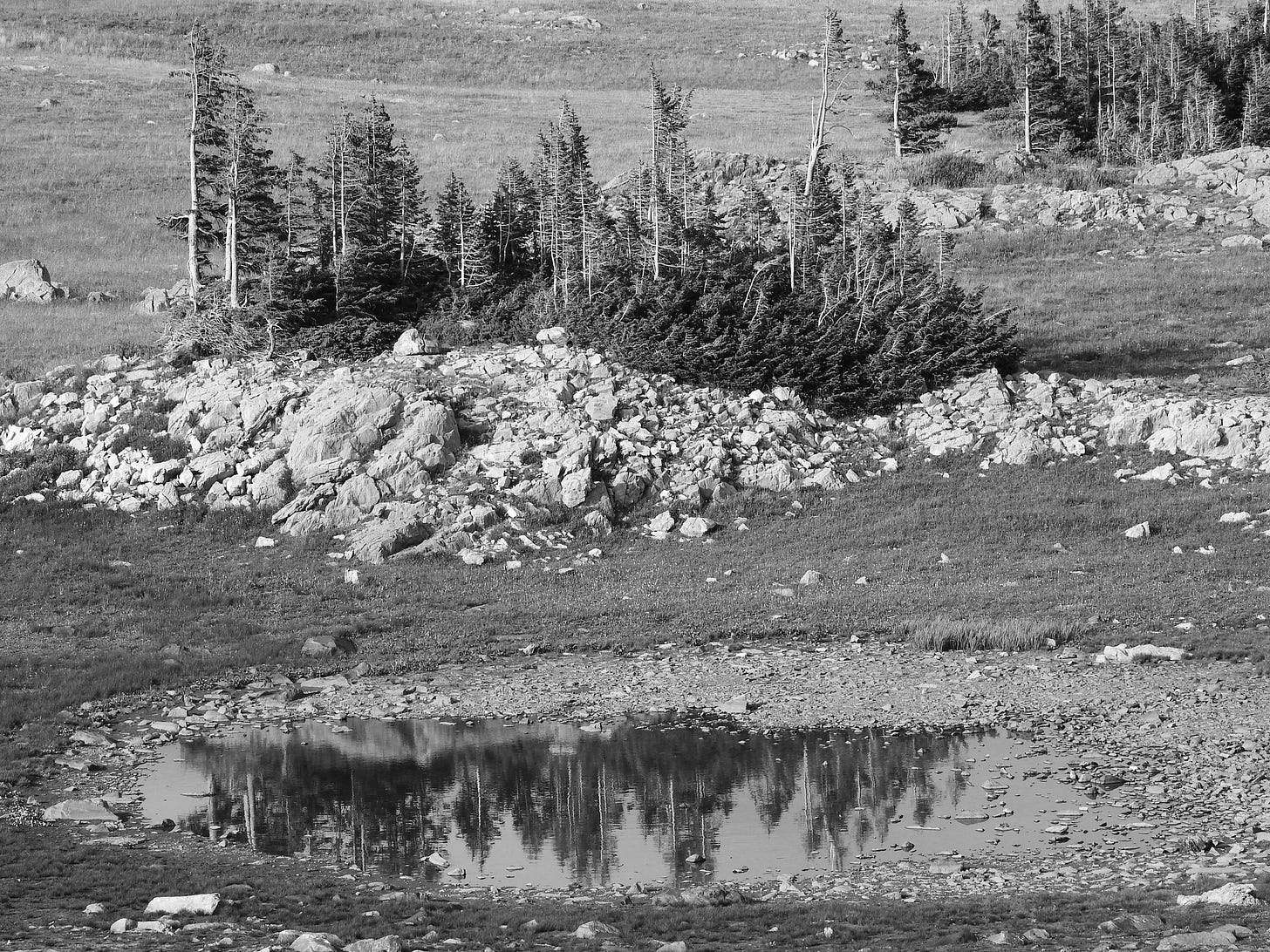The natural world is a wealth of spiritual knowledge and insight. It often helps me to relate to the ‘real’ world and see life from a greater, holistic perspective. A powerful spiritual place for me is in the Snowy Range Mountains of Southeast Wyoming. My family and I often travel there in the winter to ski and return in the summer to hike, fish, and relax in the beautiful environment.
Whenever I return to this place, I look for surprises and take them along in my memory and heart for several months, a “Lectio Divina of Nature”. One such experience that has touched me for a long time happened the first time I traveled there in the summer. My Mom and I had pulled off the highway at nearly 11,000’ elevation, to hike a short trail, climb the observation deck and take in the awe-inspiring views. The weather was quite a change from lower elevations: the wind was blowing, and it felt very chilly for a long summer day. We donned another layer of clothing before our hike. As we ventured out, we saw many plants and trees that were clumped together in groups, very low to the ground, with large spaces of green grass and rocks in between. Marmots were playfully scurrying around the boulders near the observation deck. Behind us the Snowy Range mountains loomed large, the highest peak at just over 12,000’. How can anything grow up here in this wind and chill, I wondered.
Then, at first glance, we saw what resembled a Christmas tree lying on its side. It was beautiful, wide, and green, and seemed very out of place. How could such a large tree stay green after being tipped over? On closer inspection, we realized, it was made up of many trees of various heights, all grouped together tightly. A sign nearby revealed its name: a krummholz. It is a group of small trees that live above 9,000’ elevation and survive by sheltering each other. The predominant winds shear and prune branches on the windward sides of the trees; snow and ice inhibit growth of the tender buds. On the less windy side, there are often normal appearing branches, causing many trees in the krummholz to have missing branches on one side, called ‘flag’ trees. Growth only happens on the taller trees on the lee side, often in a step-wise pattern, which leads to the appearance of an evergreen tree lying on its side. These trees have been growing for hundreds of years, getting just a little taller each short growing season. The smaller trees can only grow as much as the protection from the taller trees allow. For the entire group of trees to survive, the flag trees must lose part of their branches to protect the entire krummholz. Amazing!
Image: Short greenery gradually increasing in height to tall trees, in a step-wise fashion from left to right. Gray mountains with patches of snow in the background on a cloudy day. Libby Flats, Snowy Range Mountains, SE Wyoming.
I pondered this for a long time, and my mind frequently returned to Chapter 72 of the Rule of Benedict. It’s one of my favorite chapters of the Rule. Here is an excerpt from a paraphrase of this chapter: The Right Kind of Passion:
“Just as there are bad passions that lead us away from God to our own destruction, so too there are good passions that set us on fire to chase after God and the life that’s really life. This is the right kind of passion that monastics must foster with fervent love: They should each try to be the first to show respect to the other (Romans12:10b). We’re on this road together, and so we must patiently bear with one another’s spiritual and physical weaknesses, giving our all to learn to listen carefully to one another. No one should look after themselves, but each one should strive to serve the others in everything. To one another, members should show pure love; to God, loving reverence; to leadership, humble love. We should not want anything more than Christ, who can bring us together to the life that lasts forever. “
“We must patiently bear with one another’s spiritual and physical weaknesses, giving our all to learn to listen carefully to one another. “
The krummholz is a clear example from the natural world on how we as humans can learn to support each other and be co-creators with the Divine (aka Attune with the Divine). Supporting each other’s growth; sheltering another as needed and valuing another person by our actions are just a few examples. The entire community depends upon this protection and support! The “flag” trees, those that lose part of their branches on one side, can be an example of humility, the way of which St Benedict shows us in Chapter 7 of his Rule. These trees offer protection to those nearby from the prevailing, blustery wind that is present in this type of environment. Without the flag trees’ vulnerability, many trees could not grow and survive here on their own. We, as humans, also need vulnerability for true growth individually and in a shared manner as we bear another’s burdens as well as our own. Caring for others allows each person to Flourish and be true to themselves as they were made by Creator.
Image: “Flag tree”, a tall evergreen tree without branches on the right side. Green meadow in the foreground, forested mountains in the background.
Image: black and white photo of a group of trees that have few or no branches on their left sides, with shorter bushes/trees and surrounded by boulders and rocks. Reflecting pool of water in foreground.
The goal of a Benedictine community is to live our lives according to Benedict’s Rule, by bringing together a mixture of experiences, backgrounds, and cultures. We serve Christ through prayer, loving service, and tending to our communities. Elders who have grown ‘tall’ in their wisdom through study, reflection, prayer, and weathering all kinds of life events give ‘shelter’ to the novices. Those that are just beginning their Benedictine journey may be like the much younger trees in the krummholz-- learning how to grow, inch by inch, in the environment where they live: a monastery, family, Oblate community, or a vocation. May the example of the krummholz prompt us to tend to our human and non-human siblings in a more intentional fashion, growing towards an ever interconnected, loving, and supportive community.
**A Benedictine Oblate is affiliated with a particular monastery (Sacred Heart Monastery, Yankton, SD in my case) and who promises to live their life according to the Rule of St. Benedict as their state in life permits. Oblates gather together regularly to study the Rule and share how we can integrate the messages Benedict gives us in our daily life. We are made up of different denominations and have our unity in Christ. Those who follow the Rule of St Benedict are counter-cultural, a living antidote to isolationism and siloing in the USA. I’m grateful for this community!
References for krummholz:
https://www.montananaturalist.org/blog-post/krummholz-tough-trees-at-timberline/
https://www.swcoloradowildflowers.com/Tree%20Enlarged%20Photo%20Pages/picea%20krummholz.htm
Resources for the Rule of St Benedict:
The Rule of Saint Benedict: A Contemporary Paraphrase by St. Benedict of Nursia, edited by Jonathan Wilson-Hartgrove, 2012.
The Rule of St. Benedict, online: https://archive.osb.org/rb/index.html
Resources for Benedictine Oblates:
https://www.yanktonbenedictines.org/






